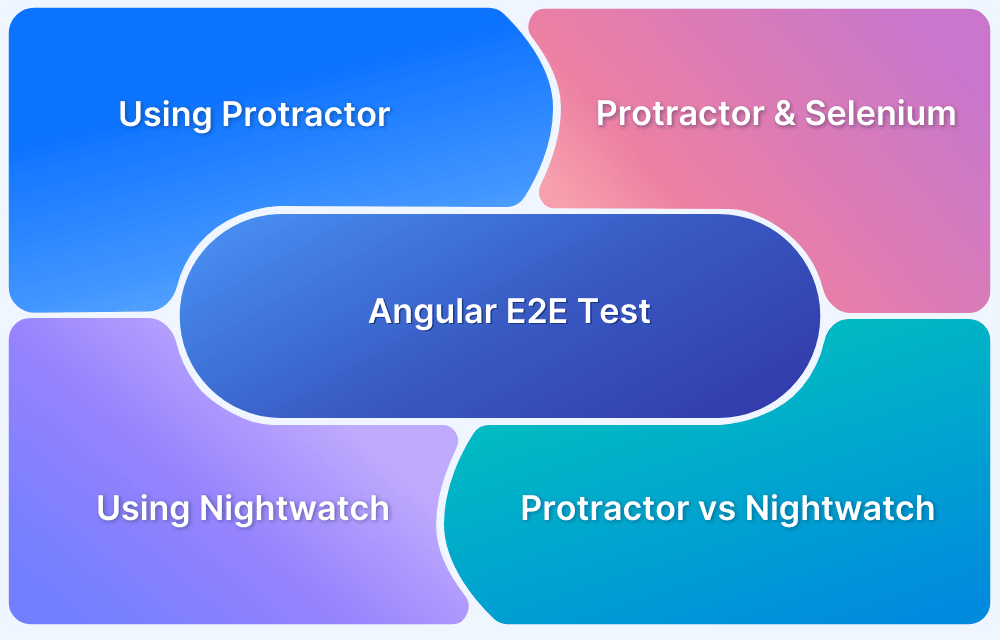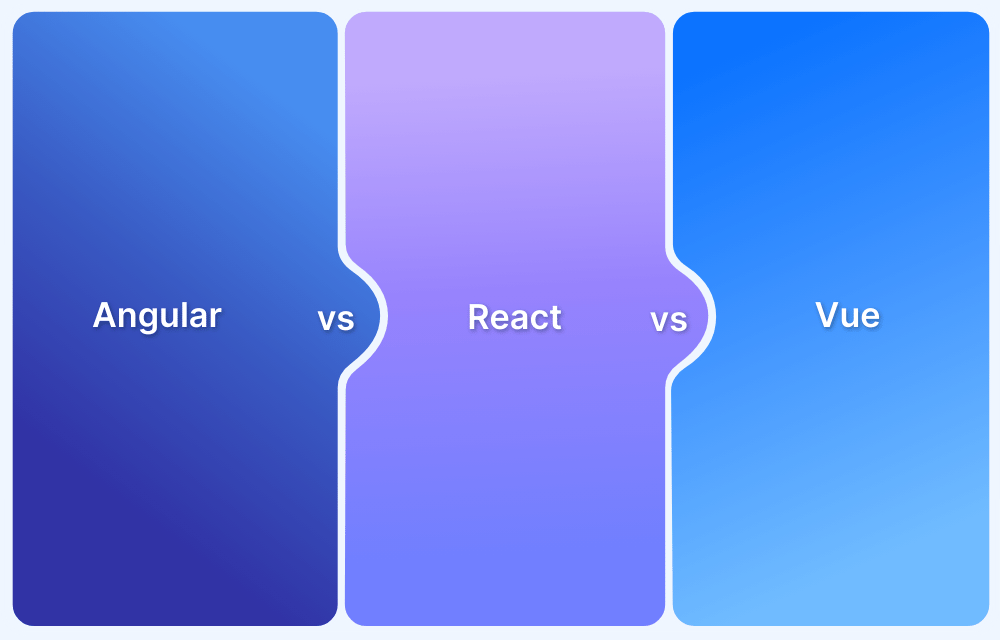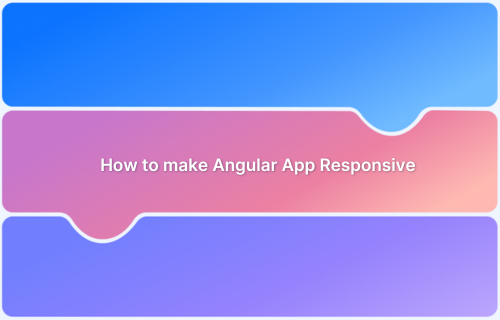Angular visual regression testing is an automated process that detects unintended visual changes in your Angular application’s user interface by comparing screenshots over time.
Overview
Importance of Angular Visual Regression Testing
Angular projects must maintain UI consistency, prevent visual bugs from reaching users, and ensure a polished, professional appearance across all components and pages. This practice significantly speeds up development by automatically catching regressions.
Best Practices of Angular Visual Regression Testing
- Automate tests within your CI/CD pipeline for early detection.
- Strategically scope tests on critical UI and version control your baselines.
- Prioritize testing key components and critical user flows.
- Implement a clear workflow for reviewing visual diffs and regularly update tests.
- Ensure consistency by testing across different browsers and viewport sizes.
This article talks about the essentials of Angular visual regression testing, from its importance and challenges to the best practices for successful implementation.
Importance of Visual Regression Testing
Visual regression testing in Angular development offers key advantages beyond bug detection, enhancing application quality and streamlining your workflow:
- Ensuring visual consistency: Visual regression testing is aimed to test the visual properties of a user interface. It helps to ensure that there are no visual discrepancies between the current version of your Angular-based web development project and previous versions. This helps maintain visual consistency across all web pages.
- Fix visual defects: With visual regression testing, you can detect regression defects, such as broken layout, images, and overlapping text. This helps to improve the user experience by fixing issues before they become problematic.
- Automation friendliness: Automated visual regression testing is easy and can save significant development time as it helps to identify and fix visual issues thoroughly.
- Increase team collaboration: Discussing and analysing UI quality helps increase collaboration among team members, including designers, developers, and QA engineers. This results in better communication increased productivity, and better final product quality.
- Improve user satisfaction: Visual regression testing helps ensure the user experience is consistent and high-quality. This results in higher user satisfaction and fewer support requests.
- Boost SEO: The visual appeal and consistency of a website can have a significant impact on SEO. Visual regression testing helps ensure that your website looks good and performs well, which can improve search engine rankings and attract more traffic.
- Angular-specific issues: Angular-based web development can present unique challenges that require specific testing. Visual regression testing can help developers identify issues related to the framework’s complex structure, such as broken links or compatibility issues, which can be challenging to detect manually.
Angular Visual Regression Testing
Visual testing is carried out after the component development is complete on the developer side, so it is agnostic of how the application was built. Most visual testing frameworks analyze the final application, and not the functional code.
The official angular docs on testing will not explicitly mention best practices for visual testing as it is a client-side activity. So it is advised you do your research and choose your testing tools wisely.
This is exactly where Percy comes in. Due to its broad integration capabilities you can easily integrate any popular framework of your choice with BrowserStack Percy and start running your visual testing for a bunch of use cases like:
Here is an overview on how to use the most popular tools available :
Angular Visual Regression Testing with Selenium and Percy
Percy offers advanced features for taking screenshots, pixel comparisons and building approval workflow. To get started, Create a BrowserStack account and set up a new project for your Angular app on the Percy dashboard.
Install the necessary dependencies and frameworks for running visual regression tests with your preferred tool. Set up your test scripts to launch your Angular app and take screenshots at different stages of the test with Selenium:
Installation:
npm install --save-dev @percy/cli @percy/selenium-webdriver
Import into file required dependencies:
const { Builder } = require('selenium-webdriver');
const percySnapshot = require('@percy/selenium-webdriver');Define the webdriver:
let driver = await new Builder().forBrowser('firefox').build();Launch page and take snapshot:
await driver.get('http://localhost:4200/');
await percySnapshot(driver, ‘Angular App’);Close the driver:
await driver.quit();
Finally, for executing the script, declare the PERCY_TOKEN variable and launch the script using node and you will get this output :
$ export PERCY_TOKEN=[your-project-token] $ percy exec -- node script.js [percy] Percy has started! [percy] Created build #1: https://percy.io/[your-project] [percy] Running "node script.js" [percy] Snapshot taken " Angular App" [percy] Stopping percy... [percy] Finalized build #1: https://percy.io/[your-project] [percy] Done!
Angular Visual Regression With Cypress and Percy
One way to implement automated visual testing with Angular is through using Cypress, an end-to-end testing tool that allows for automated testing of web applications..
To get started with visual testing with Cypress and Percy, developers should first install the necessary packages:
install --save-dev @percy/cli @percy/cypress
A Cypress test code with Percy snapshot function :
import '@percy/cypress';
describe('Integration test with visual testing', function() {
it('Loads the homepage', function() {
// Load the page or perform any other interactions with the app.
cy.visit(“http://localhost:4200”);
// Take a snapshot for visual diffing
cy.percySnapshot();
});
});With this code, you can load the deployed page and take a snapshot for visual comparison.
To run the test and upload the results to Percy, developers can use the following command:
export PERCY_TOKEN=<your token here> percy exec -- cypress run
After running the scripts the results will be uploaded to Percy and can be accessed inside your project on the Percy dashboard.
Testing Angular Storybook with Percy
Percy Storybook is a Percy module built for testing Storybook which is a popular by component library used with content frameworks like React, Angular Vue etc.
To get started with Percy Storybook visualtesting, developers can first install the module with the following command:
npm i --save-dev @percy-io/percy-storybook
Once installed, a script should be added to the project’s package.json file to define the snapshot behavior:
"snapshot": "build-storybook && percy-storybook --widths=320,1280"
In addition, the following code should be added to the .storybook/config.js file, which sets up the Percy addon and allows for the serialization of stories:
//Adjust the existing line that imports @storybook/angular
import { configure, getStorybook, setAddon } from '@storybook/angular';
// in config.js, add the following before calling configure to configure your stories
import createPercyAddon from '@percy-io/percy-storybook';
const { percyAddon, serializeStories } = createPercyAddon();
setAddon(percyAddon);
// add the following at the end of your config
serializeStories(getStorybook);And Set access token in env :
# Unix export PERCY_TOKEN="<your-project-token>" # Windows set PERCY_TOKEN="<your-project-token>"
Once set up, developers can run Percy Storybook to test a locally hosted version of the site:
percy storybook http://localhost:4200
With Percy Storybook, developers can easily automate the testing of their Angular Storybook components, ensuring that changes to their UI do not have any unintended visual consequences.
Enhance Angular Visual Testing with BrowserStack Percy
While manual screenshot comparison works for small projects, scaling visual regression testing across Angular applications requires a more robust solution. Percy by BrowserStack is an AI-powered visual testing platform designed specifically for modern web frameworks like Angular.
Why Percy for Angular Visual Testing?
- Effortless Integration: Percy integrates seamlessly with Angular testing frameworks like Jasmine, Karma, and Protractor with just a single line of code. It works within your existing CI/CD pipelines to automatically capture screenshots on every commit.
- AI-Powered Intelligence: Percy’s Visual AI Engine eliminates the frustration of false positives by automatically ignoring visual noise from animations, dynamic content, and anti-aliasing, which are common challenges in Angular applications with rich UI components. It focuses only on meaningful layout shifts and styling changes that actually impact user experience.
- Accelerated Reviews: The Visual Review Agent highlights impactful changes with bounding boxes and human-readable summaries, helping teams review visual diffs up to 3x faster. Each test run generates a build with comprehensive history and side-by-side comparisons.
- Comprehensive Coverage: Test your Angular components across 3500+ browsers and devices to ensure pixel-perfect rendering everywhere. Percy supports comparing staging and production environments, scheduled scans, and flexible monitoring options.
- Team Collaboration: Share visual test results directly through Slack or your CI pipeline, enabling faster root cause analysis and team-wide visibility into UI changes.
Pricing
- Free Plan: Available with up to 5,000 screenshots per month, ideal for getting started or for small projects.
- Paid Plan: Starting at $199 for advanced features, with custom pricing available for enterprise plans.
Common Challenges in Angular Visual Regression Testing
While invaluable, visual regression testing in Angular applications has hurdles.
Effectively navigating these common challenges is key to a stable and reliable visual testing strategy.
- Handling Dynamic Content and Animations: Components with dynamic content (e.g., ads, user-specific data) or animations can cause tests to fail due to expected variations. Strategies to mock data or freeze animations become crucial.
- Managing Asynchronous Operations and UI Settling: Angular applications often load data or update the UI asynchronously. Tests must intelligently wait for the UI to reach a stable state before capturing a screenshot to avoid premature comparisons.
- Addressing Flaky Tests and False Positives: Minor rendering differences, anti-aliasing effects, or tiny pixel shifts unrelated to bugs can lead to flaky tests. Fine-tuning comparison thresholds or ignoring specific regions is often necessary.
- Maintaining Baselines Across Different Browsers and Viewports: Different browser rendering engines and responsive design changes across viewports can produce slight visual deviations. This necessitates separate baselines or smart comparison logic to manage effectively.
Must Read: Best Practices for Visual Testing
Best Practices for Angular Visual Regression Testing
Consider adopting the following best practices to maximize the effectiveness of visual regression testing in your Angular projects and ensure a smooth workflow.
These guidelines help maintain test stability, relevance, and overall quality.
1. Integrate into Your CI/CD Pipeline
Embed visual tests into your CI/CD pipeline for early defect detection with every code change. Configure automated notifications for immediate team alerts on any visual discrepancies.
2. Define a Clear Test Plan and Scope
Develop a precise test plan detailing objectives and requirements covering Angular application areas. This ensures critical UI elements are consistently monitored for visual accuracy.
Also Read: Test Plan vs Test Case: Core Differences
3. Use Version Control for Baselines and Test Scripts
Manage visual baselines and test scripts using version control systems like Git. This tracks changes, aids collaboration, enables rollbacks, and links visual changes to code modifications.
4. Strategically Select Pages and Components for Testing
Prioritize critical user flows, key components, and high-traffic pages for visual testing. Focusing on high-impact areas optimizes testing efforts and resource use.
5. Implement a Robust Review and Approval Workflow for Visual Diffs
Establish a transparent, collaborative workflow for reviewing flagged visual differences with key stakeholders. Efficiently decide if changes are intended updates or regressions, using tool features to manage baselines.
6. Regularly Review and Update Your Test Suite
Keep your visual test suite current with application updates by periodically reviewing and modifying test cases. This maintains the relevance and accuracy of your visual regression tests.
7. Consider Different Browsers and Viewport Sizes
Validate visual consistency by configuring tests to capture screenshots across all supported browsers and viewport sizes. This helps promptly identify rendering issues or responsive design flaws.
Conclusion
Visual regression testing is vital for modern Angular development, safeguarding your application’s UI integrity and user experience.
By catching unintended visual changes early, teams can ensure consistency, accelerate growth, and deploy more confidently. Leveraging appropriate tools and best practices makes this process efficient and highly effective.
Frequently Asked Questions (FAQs)
1. What is the difference between visual regression testing and snapshot testing in Angular?
Snapshot testing in Angular typically captures the component’s data structure or HTML output. Visual regression testing, however, captures and compares actual rendered images (pixels) of the UI to detect visual differences.
2. How can visual regression testing help with Angular component libraries?
It’s invaluable for component libraries, ensuring that changes to individual components don’t unintentionally break their appearance or the visual consistency of applications. This maintains reliability across many projects.
3. Is visual regression testing only for large Angular applications?
No, visual regression testing benefits Angular applications of all sizes. It helps catch UI errors early, maintain quality, and save developer time even in smaller projects.







